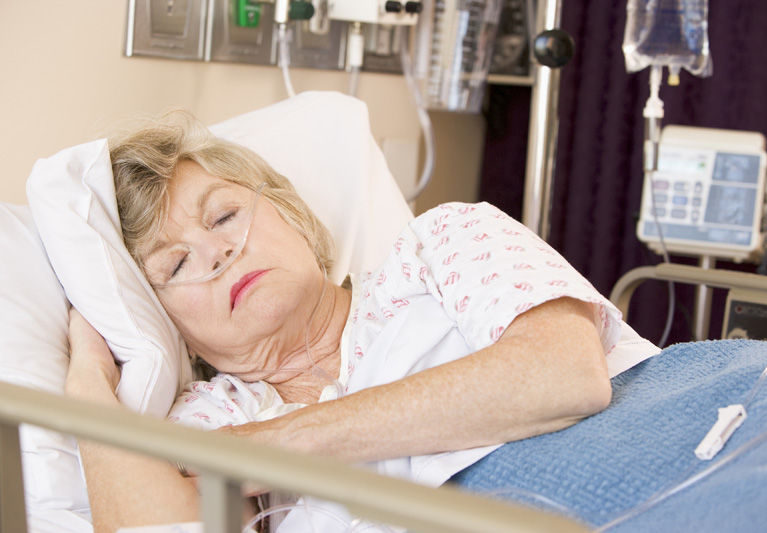
People who are afraid of going into the hospital have some legitimate reasons for their fears.
In addition to well-publicized infections such as MRSA, (Methicillin-Resistant Staphylococcus Aureus), and CRE, (Carbapenem-Resistant Enterobacteriaceae), there is a far more common health hazard lurking in hospitals, nursing homes and care facilities nationwide.
It is called Healthcare or Hospital-Acquired Pneumonia and it is the second most commonly contracted hospital infection after urinary tract infections.
It’s also among the deadliest.
Dr. Katie Hough, medical director of the Indian River Medical Center’s department of internal medicine deals with all hospital-acquired illnesses at the Vero Beach facility.
“If any patient does develop pneumonia while in the hospital,” Hough says, “we use a multi-disciplinary team to treat them. It wouldn’t just be the hospitalist. It would also be an infectious disease specialist, another physician, a lung doctor or an interventionist.”
Acting quickly, Hough says, saves lives.
But the challenge for medical professionals is formidable.
The Centers for Disease Control says 1.7 million hospital-associated infections from viruses, bacteria and fungal pathogens combine to cause, or contribute to, almost 100,000 deaths each year.
The Cleveland Clinic reports that between five and 15 of every 1,000 patients admitted to a hospital or nursing facility in this country are at risk for Hospital-Acquired Pneumonia or HAP. That’s a significantly higher risk than for MRSA and CRE infections combined.
In fairness to hospitals, nursing homes and other care facilities, many of the people they care for already have seriously compromised immune systems and often have multiple pre-existing conditions – including cardiac, kidney, liver and lung problems – that make them far more susceptible to infections than the public at large.
IRMC’s Hough is a “hospitalist,” a term first coined by the New England Journal of Medicine in 1996 for physicians specializing in the treatment of in-hospital patients. Today, the Institute for Healthcare Improvement is turning to hospitalists like Hough to help combat HAP and other healthcare-acquired infections.
The Merck Manual of Diagnosis and Therapy, the world’s best-selling medical textbook, is blunt about the prognosis for those who contract HAP. They call it “poor,” due to the co-morbidities or pre-existing conditions.
Healthline.com reports that patients who are infected with HAP, “stay in the hospital two-and-a-half times longer than uninfected patients,” typically incurring tens of thousands of dollars in additional medical expenses.
For all of these reasons, Hough and her team are extremely active in trying to prevent infections as well as watching for and treating any sign of HAP as soon as possible.
To cut the risk of infections occurring in the first place, Hough points out that, “the IRMC infectious disease staff literally watches us every minute” making sure hands are washed, gloves and gowns are worn and antimicrobial protocols are properly followed.
Hough is also a big proponent of taking prophylactic or preventive steps. For example, she emphatically states that, “Every single eligible patient that comes into this hospital is offered and recommended to have a pneumonia vaccine. This has been the practice for years. I definitely recommend it to all my eligible patients.”
In addition to the aggressive team approach to treatment she mentioned earlier, Hough says the hospital has “an antibiotic stewardship program with both physicians and pharmacists paying close attention” to which antibiotics are administered to individual patients.
In 2014 the CDC recommended that all acute care hospitals nationwide adopt similar stewardship programs.
Still, spotting cases of HAP isn’t always easy.
The National Institutes of Health’s list of symptoms includes, “mental changes or confusion,” which, frankly, is fairly common in many hospital patients and especially in seniors. NIH also lists, “general discomfort, uneasiness or malaise,” along with, “loss of appetite, nausea, vomiting, shortness of breath and coughing,” as other symptoms of HAP.
Unfortunately those are symptoms for a wide variety of other, far less dangerous problems, too.
According to the Merck Manual, chest x-rays and blood tests are the only reliable way to diagnose HAP.
One area where HAP infection is particularly common is when mechanical ventilation or intubation is required. The Cleveland Clinic claims that incidents of HAP increase by a factor of 20 in mechanically ventilated patients.
Merck Manual states that patients requiring intubation or the inserting of a breathing tube through the mouth and into the lungs are at the highest risk for HAP. The process, Merck explains, breaches the natural airway defenses, impairs or prevents coughing as well as the ability to expel phlegm and allows bacteria to spread.
“We try,” Hough sasy, “to avoid intubation whenever possible.” She adds that, when tubes are used, “they are one-time-only pieces of equipment, used once and then discarded,” so there is no chance of spreading pathogens that way.
Intubation is, of course, an extreme measure but is sometimes necessary to save lives. Common sense can play an important role, too.
“Time and time again,” says this former valedictorian of the Lake Erie College of Medicine, “something as simple as raising the head of the bed has been shown to reduce problems with intubation.”
Hough says she and her staff are determined to mobilize all the resources available to them and continue their fight against all hospital-acquired infections.
She also points out that new Medicare standards due to come out in early 2016 may actually shift some of the financial burdens caused by HAP and other healthcare-acquired infections away from patients and insurers and onto hospitals, nursing homes and other care facilities – one small ray of sunshine for anyone who succumbs to pneumonia while in a hospital or other treatment center.



